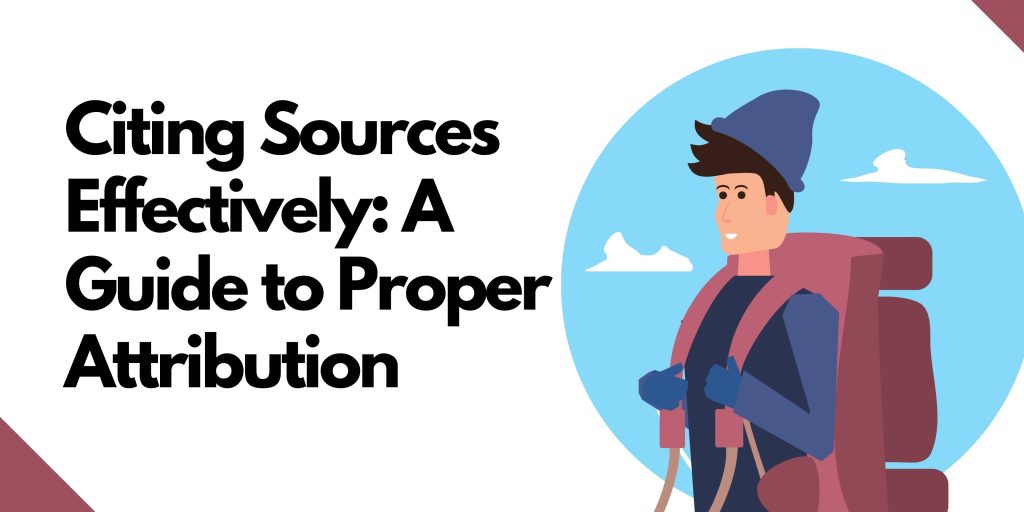Citing sources is an essential component of responsible and ethical writing. It allows you to give credit to the original authors, acknowledge their contributions, and provide readers with the opportunity to explore the sources that informed your work. Proper attribution not only upholds academic integrity but also strengthens the credibility of your writing. In this blog post, we will provide you with a comprehensive guide on how to cite sources effectively. We will cover different citation styles, discuss in-text citations and bibliographies, and provide real examples to illustrate proper attribution.
Why is Proper Attribution Important?
Proper attribution is important for several reasons:
- Giving Credit: Citing sources gives credit to the original authors for their ideas, research, and intellectual contributions. It demonstrates respect for their work and acknowledges their role in shaping your understanding of the topic.
- Avoiding Plagiarism: Citing sources is crucial in avoiding plagiarism. Plagiarism is the act of presenting someone else’s work as your own, and it can have serious consequences. By providing proper attribution, you clearly distinguish between your own ideas and those derived from external sources.
- Strengthening Credibility: Citing sources adds credibility to your writing. It shows that you have conducted thorough research and engaged with relevant literature. It allows readers to verify your claims, follow your thought process, and build upon your work.
- Supporting Further Exploration: Citing sources allows readers to delve deeper into the topic by referring to the original works. It provides a pathway for readers to access additional information and gain a broader understanding of the subject matter.
Citation Styles:
Different academic disciplines and publications use different citation styles. The most common citation styles include:
- APA (American Psychological Association): Primarily used in the social sciences, APA style emphasizes author-date in-text citations and a detailed reference list at the end of the document.
- MLA (Modern Language Association): Commonly used in the humanities, MLA style employs author-page in-text citations and a works cited list at the end of the document.
- Chicago/Turabian: Chicago style is used in various disciplines, including history, art, and literature. It offers two citation systems: notes and bibliography (footnotes or endnotes) and author-date (similar to APA style).
- Harvard: The Harvard style is widely used in the social sciences, business, and other disciplines. It utilizes author-date in-text citations and a reference list at the end of the document.
In-Text Citations:
In-text citations are used to attribute sources within the body of your work. The format and style of in-text citations depend on the citation style you are using. Here are a few examples:
- APA Style:
- Single Author: (Smith, 2022)
- Two Authors: (Smith & Johnson, 2022)
- Three or More Authors: (Smith et al., 2022)
- Direct Quote: “The quote” (Smith, 2022, p. 45)
- MLA Style:
- Single Author: (Smith 45)
- Two Authors: (Smith and Johnson 45)
- Three or More Authors: (Smith et al. 45)
- Direct Quote: “The quote” (Smith 45)
- Chicago Style (Notes and Bibliography):
- Single Author: (Smith 2022, 45)
- Two Authors: (Smith and Johnson 2022, 45)
- Three or More Authors: (Smith et al. 2022, 45)
- Direct Quote: “The quote” (Smith 2022, 45)
Bibliographies/Reference Lists:
Bibliographies or reference lists are used to provide detailed information about the sources you have cited in your work. The format and style of bibliographies depend on the citation style you are using. Here are a few examples:
- APA Style:
- Book: Author, A. A. (Year). Title of work. Publisher.
- Journal Article: Author, A. A., Author, B. B., & Author, C. C. (Year). Title of article. Title of Journal, Volume(Issue), Page numbers.
- MLA Style:
- Book: Author, Title of Book, Publisher, Year.
- Journal Article: Author, “Title of Article,” Title of Journal, Volume, Issue, Year, Page numbers.
- Chicago Style (Notes and Bibliography):
- Book: Author, Title of Book (Place of Publication: Publisher, Year), Page numbers.
- Journal Article: Author, “Title of Article,” Title of Journal Volume, no. Issue (Year): Page numbers.
Real-World Example:
To illustrate the proper attribution of sources, let’s consider an example using APA style:
In-text citation: According to Johnson (2022), the impact of climate change on global ecosystems is significant (p. 23).
Bibliography entry: Johnson, A. (2022). Climate Change and Global Ecosystems. Publisher.
In this example, the in-text citation clearly attributes the information to the author (Johnson, 2022) and provides the page number (p. 23) for specific reference. The corresponding bibliography entry includes the author’s name, the title of the work, and publication details.
Conclusion:
Proper attribution is essential for responsible and ethical writing. By citing sources effectively, you give credit to the original authors, avoid plagiarism, enhance the credibility of your work, and provide readers with the opportunity to explore the sources further. Familiarize yourself with the citation style appropriate for your discipline, master in-text citation formats, and create accurate and comprehensive bibliographies or reference lists. By adhering to these practices, you can uphold academic integrity, strengthen your writing, and contribute to the scholarly conversation in your field.
